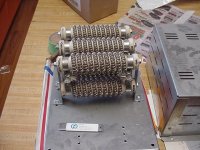Hey Guys,
I researched the dummy load thing a bit and thought about buying two 500w resistors from eBay to build a 1000w dummy load.
About the cooling solution for the resistors, I will look into it but the main issue now is:
1. What does the ohm do for my use? I know that I want a 1000w dummy load but have no idea what to choose for ohm.
2. How do I connect them? series? parallel? also heard about both...got a little confused.
3. Why do people build dummy load devices from hundreds of little resistors instead of buying a single big one for the wattage they need?
4. How do I connect a pot (and which pot ohm range) to this setup to control the load?
Roy
I researched the dummy load thing a bit and thought about buying two 500w resistors from eBay to build a 1000w dummy load.
About the cooling solution for the resistors, I will look into it but the main issue now is:
1. What does the ohm do for my use? I know that I want a 1000w dummy load but have no idea what to choose for ohm.
2. How do I connect them? series? parallel? also heard about both...got a little confused.
3. Why do people build dummy load devices from hundreds of little resistors instead of buying a single big one for the wattage they need?
4. How do I connect a pot (and which pot ohm range) to this setup to control the load?
Roy


